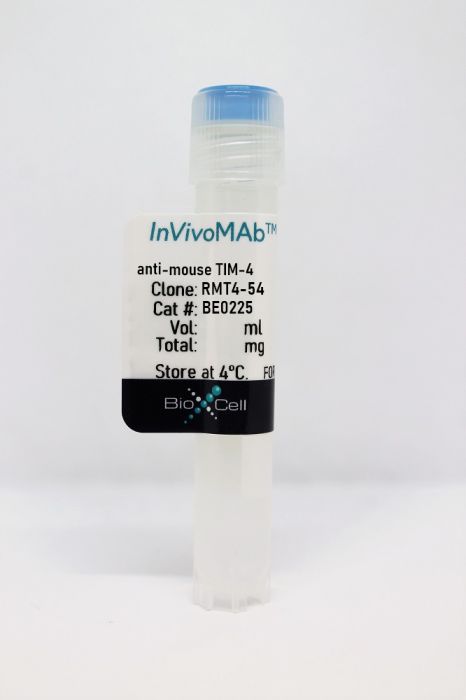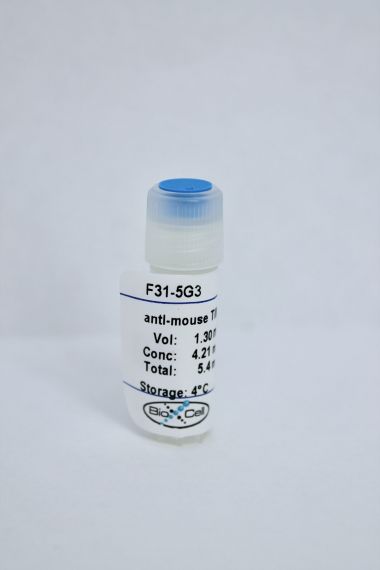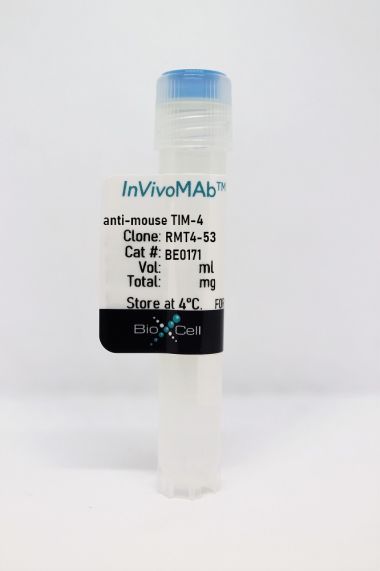InVivoMAb anti-mouse TIM-4
Product Details
The RMT4-54 monoclonal antibody reacts with mouse T cell immunoglobulin and mucin domain 4 (TIM-4) a phosphatidylserine-binding receptor and member of the Ig superfamily. TIM-4 is preferentially expressed on antigen-presenting cells. TIM-4 is thought to enhance the engulfment of apoptotic cells and play a role in regulating T cell proliferation. The RMT4-54 antibody has been shown to block TIM-4 in vitro.Specifications
| Isotype | Rat IgG2a, κ |
|---|---|
| Recommended Isotype Control(s) | InVivoMAb rat IgG2a isotype control, anti-trinitrophenol |
| Recommended Dilution Buffer | InVivoPure pH 7.0 Dilution Buffer |
| Conjugation | This product is unconjugated. Conjugation is available via our Antibody Conjugation Services. |
| Immunogen | Mouse TIM-4-Ig fusion protein |
| Reported Applications |
in vitro TIM-4 blocking Immunofluorescence Flow cytometry |
| Formulation |
PBS, pH 7.0 Contains no stabilizers or preservatives |
| Endotoxin |
<2EU/mg (<0.002EU/μg) Determined by LAL gel clotting assay |
| Purity |
>95% Determined by SDS-PAGE |
| Sterility | 0.2 µm filtration |
| Production | Purified from cell culture supernatant in an animal-free facility |
| Purification | Protein G |
| RRID | AB_2687708 |
| Molecular Weight | 150 kDa |
| Storage | The antibody solution should be stored at the stock concentration at 4°C. Do not freeze. |
Recommended Products
Flow Cytometry
Lal, G., et al. (2015). "Interleukin-10 From Marginal Zone Precursor B-Cell Subset Is Required for Costimulatory Blockade-Induced Transplantation Tolerance" Transplantation 99(9): 1817-1828. PubMed
BACKGROUND: Blocking CD40-CD40L costimulatory signals induces transplantation tolerance. Although B-cell depletion prevents alloantibody formation, nonhumoral functions of B cells in tolerance have not been well characterized. We investigated whether specific subsets of B cell or B cell-derived interleukin (IL)-10 contribute to tolerance. METHODS: Wild type C57BL/6, or B cell-specific interleukin (IL)-10 (CD19-Cre::IL-10) mice, received vascularized BALB/c cardiac allografts. BALB/c donor-specific splenocyte transfusion and anti-CD40L monoclonal antibody were used as tolerogen. B cells were depleted with antimouse CD20 monoclonal antibody. Various B-cell subsets were purified and characterized by flow cytometry, reverse transcription polymerase chain reaction, and adoptive transfer. RESULTS: B-cell depletion prevented costimulatory blockade-induced allogeneic tolerance. Costimulatory blockade increased IL-10 in marginal zone precursor (MZP) B cells, but not other subsets. In particular, costimulatory blockade did not change other previously defined regulatory B-cell subsets (Breg), including CD5CD1d Breg or expression of TIM1 or TIM4 on these Breg or other Breg cell subsets. Costimulatory blockade also induced IL-21R expression in MZP B cells, and IL-21R MZP B cells expressed even more IL-10. B-cell depletion or IL-10 deficiency in B cells prevented tolerance in a cardiac allograft model, resulting in rapid acute cardiac allograft rejection. Adoptive transfer of wild type MZP B cells but not other subsets to B cell-specific IL-10 deficient mice prevented graft rejection. CONCLUSIONS: CD40 costimulatory blockade induces MZP B cell IL-10 which is necessary for tolerance. These observations have implications for understanding tolerance induction and how B cell depletion may prevent tolerance.
Immunofluorescence, Flow Cytometry
Tacke, R., et al. (2015). "The transcription factor NR4A1 is essential for the development of a novel macrophage subset in the thymus" Sci Rep 5: 10055. PubMed
Tissue macrophages function to maintain homeostasis and regulate immune responses. While tissue macrophages derive from one of a small number of progenitor programs, the transcriptional requirements for site-specific macrophage subset development are more complex. We have identified a new tissue macrophage subset in the thymus and have discovered that its development is dependent on transcription factor NR4A1. Functionally, we find that NR4A1-dependent macrophages are critically important for clearance of apoptotic thymocytes. These macrophages are largely reduced or absent in mice lacking NR4A1, and Nr4a1-deficient mice have impaired thymocyte engulfment and clearance. Thus, NR4A1 functions as a master transcription factor for the development of this novel thymus-specific macrophage subset.
in vitro TIM-4 blocking
Nakayama, M., et al. (2009). "Tim-3 mediates phagocytosis of apoptotic cells and cross-presentation" Blood 113(16): 3821-3830. PubMed
Phagocytes such as macrophages and dendritic cells (DCs) engulf apoptotic cells to maintain peripheral immune tolerance. However, the mechanism for the recognition of dying cells by phagocytes is not fully understood. Here, we demonstrate that T-cell immunoglobulin mucin-3 (Tim-3) recognizes apoptotic cells through the FG loop in the IgV domain, and is crucial for clearance of apoptotic cells by phagocytes. Whereas Tim-4 is highly expressed on peritoneal resident macrophages, Tim-3 is expressed on peritoneal exudate macrophages, monocytes, and splenic DCs, indicating distinct Tim-mediated phagocytic pathways used by different phagocytes. Furthermore, phagocytosis of apoptotic cells by CD8(+) DCs is inhibited by anti-Tim-3 mAb, resulting in a reduced cross-presentation of dying cell-associated antigens in vitro and in vivo. Administration of anti-Tim-3 as well as anti-Tim-4 mAb induces autoantibody production. These results indicate a crucial role for Tim-3 in phagocytosis of apoptotic cells and cross-presentation, which may be linked to peripheral tolerance.





